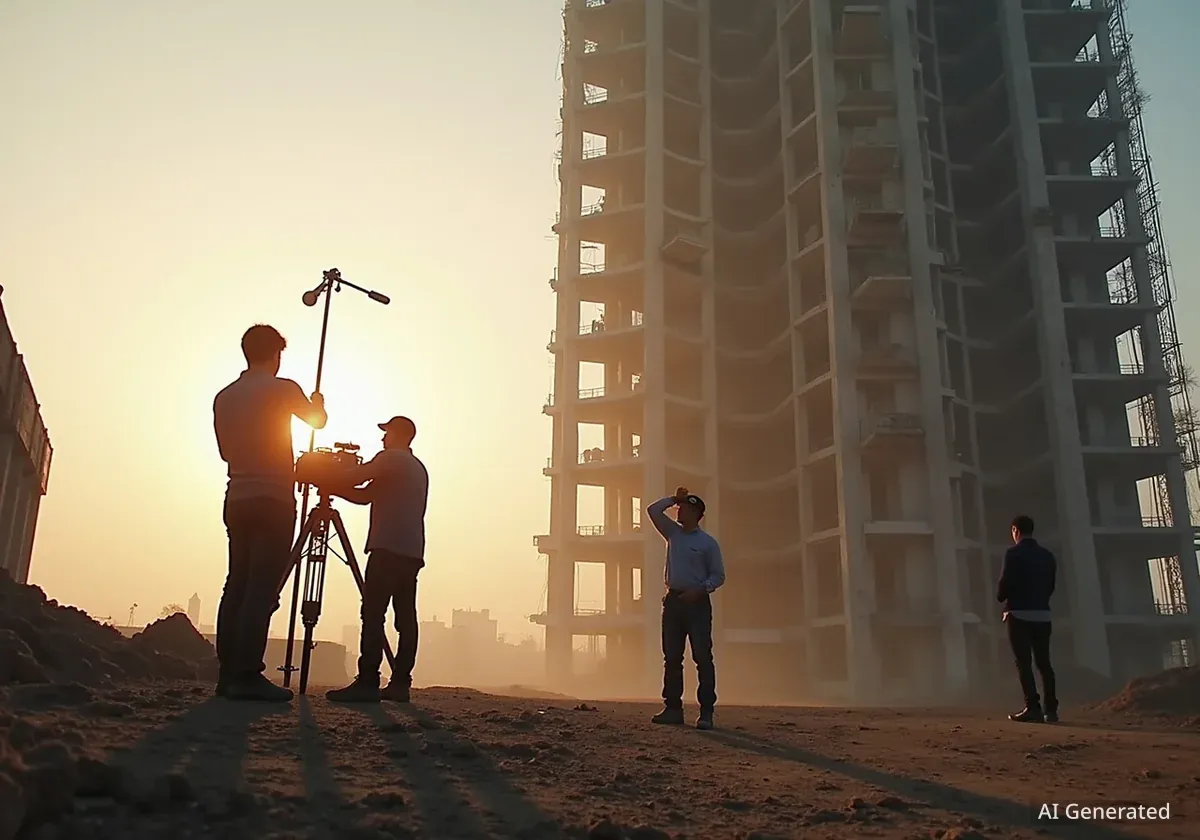In China, a striking contrast is emerging where the country's struggling real estate sector and its booming entertainment industry intersect. Unfinished residential and commercial buildings, symbols of a property market crisis, are now being repurposed as lavish film sets for the nation's rapidly expanding micro-drama industry.
This unlikely partnership provides a temporary use for vacant properties while fueling a new form of digital content that has captured a massive audience. The trend highlights both the deep-seated issues in China's property market and the creative adaptability of its entertainment sector.
Key Takeaways
- Stalled real estate developments across China are being rented out as filming locations for the popular micro-drama format.
- China's micro-drama market size exceeded 50.5 billion yuan (US$7.1 billion) in 2024, with projections suggesting it could reach 85.6 billion yuan by 2027.
- The audience for these short-form dramas surpassed 660 million people in 2024, and for the first time, industry revenue overtook the national movie box office.
- This trend creates a visual paradox, with opulent on-screen stories filmed against a backdrop of real-world economic distress in the property sector.
A Paradox in Henan Province
A clear example of this phenomenon can be found in Xingyang, a city in Henan province. A large, stalled real estate project developed by Evergrande, one of China's most indebted property firms, now serves two very different purposes.
On one hand, frustrated homebuyers who made payments years ago continue to seek updates on their unfinished apartments. Their concerns are often voiced on social media, painting a picture of financial uncertainty and delayed dreams.
On the other hand, the project's ornate and deserted sales hall has been transformed into a bustling film set. Production crews use the space, with its grand chandeliers and luxurious decor, to shoot scenes for micro-dramas, often centered on themes of romance, wealth, and family conflict.
What Are Micro-Dramas?
Micro-dramas, or "duanju," are short-form, episodic television shows designed for mobile viewing. Each episode typically lasts only a few minutes, featuring fast-paced plots and dramatic cliffhangers to keep viewers engaged. They have become a dominant force in China's digital entertainment landscape.
The Meteoric Rise of a New Media Format
The micro-drama industry has experienced explosive growth over the past several years, becoming one of the most dynamic segments of China's entertainment market. Its rise has been fueled by the country's vast mobile internet user base and a demand for quick, accessible content.
According to data from the China Television Drama Production Industry Association (CTDPIA), the market's value has soared. In 2024, it was estimated to be worth more than 50.5 billion yuan (US$7.1 billion).
Industry analysts project continued expansion, with the market potentially reaching 63.43 billion yuan in 2025. By 2027, forecasts suggest the industry's value could climb as high as 85.6 billion yuan.
Surpassing the Big Screen
In a significant milestone for the industry, the total revenue generated by micro-dramas in 2024 surpassed China's national movie box office revenue for the first time. This shift indicates a major change in how Chinese consumers spend their entertainment budgets.
An Audience of Hundreds of Millions
The appeal of micro-dramas is widespread, attracting a massive and diverse viewership. In 2024, the number of people watching these short-form series exceeded 660 million nationwide. This audience spans from residents of major tier-one cities like Beijing and Shanghai to those in smaller towns and rural areas.
The most popular genres often involve urban romance and corporate power struggles. These stories frequently take place in high-end settings, such as luxurious office buildings, opulent mansions, and expensive apartments, which drives the demand for such locations.
A Symbiotic, If Limited, Relationship
The convergence of the struggling property market and the booming micro-drama industry has created a practical, albeit temporary, solution for both sides. For property developers facing cash flow shortages and construction halts, renting out empty spaces provides a small but welcome stream of income.
"This trend offers a glimpse into how different sectors of the economy are adapting to the ongoing property crisis. While it doesn't solve the underlying problems, it creates a small-scale economic activity where there was none," an industry insider noted.
For film producers, these stalled projects offer a cost-effective alternative to building expensive sets. They gain access to ready-made, high-end locations that fit the aspirational narratives of their most popular shows. The empty sales halls, model apartments, and deserted office lobbies are perfect backdrops for stories about the wealthy elite.
Broader Economic Impact Remains Minimal
While this repurposing brings a flurry of activity to otherwise dormant construction sites, experts caution that its overall economic impact is limited. The rental fees paid by production companies are minor compared to the massive debts and financial obligations of the property developers.
Furthermore, this activity does not address the core issue for homebuyers who are still waiting for their properties to be completed. The on-screen fantasy of wealth and success, filmed inside the very buildings they cannot inhabit, creates a stark and often painful irony.
Ultimately, the use of these stalled projects as film sets is a symptom of a larger economic imbalance. It illustrates a creative adaptation to a crisis but does not offer a sustainable solution to the deep-rooted challenges facing China's real estate sector.





